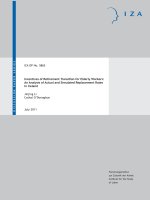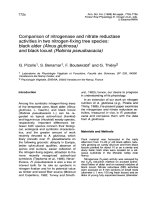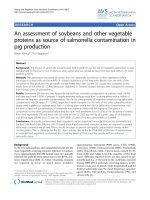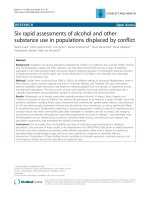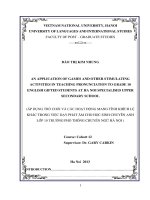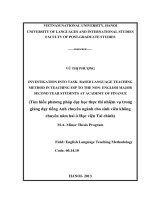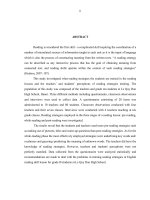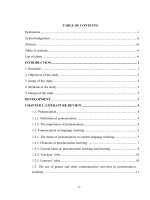an application of games and other stimulating activities in teaching pronunciation to grage 10 english gifted student at ha noi specialised upper secondary school
Bạn đang xem bản rút gọn của tài liệu. Xem và tải ngay bản đầy đủ của tài liệu tại đây (748.68 KB, 35 trang )
VIETNAM NATIONAL UNIVERSITY, HANOI
UNIVERSITY OF LANGUAGES AND INTERNATIONAL STUDIES
FACULTY OF POST – GRADUATE STUDIES
----------
ĐÀO THỊ KIM NHUNG
AN APPLICATION OF GAMES AND OTHER STIMULATING
ACTIVITIES IN TEACHING PRONUNCIATION TO GRADE 10
ENGLISH GIFTED STUDENTS AT HA NOI SPECIALISED UPPER
SECONDARY SCHOOL
(ÁP DỤNG TRÒ CHƠI VÀ C C HO T
NG MANG TÍNH KHÍCH LỆ
KHÁC TRONG VIỆC D Y PHÁT ÂM CHO HỌC SINH CHUYÊN ANH
LỚP 10 TRƯỜNG PHỔ THÔNG CHUYÊN NGỮ HÀ N I )
Course: Cohort 12
Supervisor: Dr. GARY CARKIN
Ha Noi 2013
INTRODUCTION………………………………………………………………….4
1. Rationale………………………………………………………………………….4
1
2. Objectives of the study……………………………………………………………5
3. Scope of the study………………………………………………………………...5
4. Methods of the study……………………………………………………………...5
5. Design of the study……………………………………………………………….5
DEVELOPMENT………………………………………………………………………….6
CHAPTER 1: LITERATURE REVIEW…………………………………………6
1.1. Pronunciation ……………………………………………………………..........7
1.1. Definition of pronunciation ……………………………………………………7
1.2. The impotance of pronunciation ………………………………………………7
2. Pronunciation in language teaching ……………………………………………..8
2.1.The status of pronunciation teaching……………………………………............8
2.1.1. The vowel and consonant sounds ……………………………………………9
2.1.2. Words stress pattern………………………………………………………….9
2.1.3. rhythm………………………………………………………………………..9
3. Current ideason pronunciation teaching and writing …………………………….9
4. Teachers’ roles …………………………………………………………………10
5. Learners’ roles …………………………………………………………………..10
6. The use of games and other communicative activities in pronunciation teaching …….11
CHAPTER 2. MOTHODOLOGY………………………………………………13
1. Context of the study……………………………………………………………..13
2. game……………………………………………………………………………..13
3. instruments………………………………………………………………………14
4. Questionaire …………………………………………………………………….15
5. Teacher’s note ………………………………………………………………….15
CHAPTER 3. DATA PRESENTATION, ANALYSIS AND DISCUSSION ..16
1. Responces to the questionaire …………………………………………………..16
2. Qualitative to the questionaire ………………………………………………….17
3. Diagnotic Test Analysis ………………………………………………………..18
4. The reseacher’s observation during class time through out the course ………...20
5. Dicussion ………………………………………………………………………. 21
6. The effectiveness game and other stimulating activities ………………………. 22
CONCLUSION……………………………………………………………………25
1. Conclusion………………………………………………………………………25
2. Implications…………………………………………………………………..…25
REFERENCES……………………………………………………………………27
APPENDICES ………………………………………………………………........28
2
INTRODUCTION
1. Rationale
It is undeniable that English has become a language of global
communication thanks to its contribution to different fields of our life such as:
science, technology, aviation, diplomacy and so on. No one can deny that the
rapid expansion of information technologies and the spread of globalization
have led to an explosion in the demand for English worldwide.
English is now taught throughout of Vietnam in different levels of
education from primary schools to universities because it serves as an
international language and as a mean to promote mutual understanding and
cooperation between Vietnam and other countries. In fact, more and more
people desire to know and master English in order to keep them up-to-date with
the global development. As a result, English is taught not only at schools and
universities but also at many foreign language centres, on radio, television and
even via the internet. However, both teaching and learning of English are still
far from being satisfaction. One main problem is that most Vietnamese learners
are rather good at English writtenly but not orally. Many of them have a good
command of grammar and vocabulary, which promises very high marks in
written tests, but cannot communicate successfully with foreigners. The reason
lies in the imbalanced development of four language skills. In most schools and
universities (except those whose major is English), teachers focus too much on
reading and writing rather than speaking and listening of which pronunciation is
a good foundation. Thus, students do not often have English competence,
especially in oral communication.
In the present context of teaching English at CNN, speaking and listening
are very important for grade 10 students because they establish a firm base for
students’ further development, especially in interpreting skills.
Being a teacher of English in general, I am well aware of the importance of
pronunciation to help my students improve these skills, but like other teachers, I
have faced many difficulties in creating motivation so that students are eager to
practise in and out of their classes.
4
We have questioned ourselves about how to motivate our students to
maximize their time of practising in class and even outside class, which leads to
the use of games and other stimulating activities. We have tried activities
collected from different sources, which seems to bring about great effect.
2. Objectives of the study
The study is aimed at:
Finding out their advantages and disadvantages.
Helping pronunciation teachers choose suitable activities for their classes.
Thus, this thesis is to answer two research questions:
How effective is the use of games and some other stimulating activities?
What are students’ attitude towards the use of games and some other
stimulating activities?
3. Scope of the study
To create motivation for students in pronunciation classes, teachers at
English group, CNN, have applied a lot of games and activities. However, the
researcher in this study only focuses on and analyzes some typical ones (which
will be presented in the following parts) and then suggests some effective
activities that teachers can introduce to students so that they have more practice
outside class. There are 4classes at grade 10 which consist of 160 students who
have to take pronunciation as a compulsory subject; however, this action
research was carried out in only two classes of which the researcher was in
charge. Thus, the questionnaire was delivered to only 50 participants.
4. Methods of the study
Action research is the method employed in this study. To achieve the aims
mentioned above, the researcher has used a number of instruments to collect
data for analysis which include a questionnaire distributed before the term
started and after it ended, teachers’ observation and notes.
5. Design of the study
This minor thesis is composed of three parts.
Part 1, INTRODUCTION, presents the rationale, aims, scope, methods and
design of the study.
5
Part 2, DEVELOPMENT, is divided into three chapters.
Chapter 1, Literature Review, presents relevant concepts to pronunciation
and pronunciation teaching.
Chapter 2, Methodology, involves the information about context,
participants and instruments of the study.
Chapter 3: Data Presentation, Analysis and Discussion, focuses on data
analysis to show students’ point of view towards pronunciation and the
effectiveness of different activities.
Part 3, CONLUSION, summarizes some major findings, provide
implications for pronunciation teaching, limitation of the study and suggestions
for further research.
6
DEVELOPMENT
LITERATURE REVIEW
1.Pronunciation
1.1. Definition of pronunciation
There are various ways to define pronunciation. Macmillan Dictionary
gives an easy-to-understand definition, that is “the way in which a word or
language is pronounced”.
Similarly, Oxford Advanced Learner’s Dictionary defines pronunciation as
the way in which a language or a particular word or sound is pronounced or the
way in which a particular person pronounces the words of a language.
More specifically, pronunciation can be understood as one of the three
explanations given in the :
The act or manner of pronouncing words; utterance of speech.
A way of speaking a word, especially a way that is accepted or generally
understood.
A graphic representation of the way a word is spoken, using phonetic
symbols.
1.2. The importance of pronunciation
Nowadays, no one can deny the significant role of pronunciation in
language teaching and learning. Pronunciation is one of the most important
aspects of language. We may be proficient at grammar and have a huge store of
vocabulary, but if we pronounce words wrongly, we just will not get understood.
Wong (1993) argues that the importance of pronunciation is even more distinct
when the connection between pronunciation and listening comprehension is
considered. As listeners expect spoken English to follow certain patterns of
rhythm and intonation, speakers need to employ these patterns to communicate
effectively. If the rhythm and intonation are different, listeners simply can’t get
the meaning. Similarly, listeners need to know how speech is organized and
what patterns of intonation mean in order to interpret speech accurately. Thus,
learning about pronunciation develops learners’ abilities to comprehend spoken
7
English. Furthermore, Wong demonstrated that a lack of knowledge of
pronunciation could even affect students’ reading and spelling.
2. Pronunciation in language teaching
2.1. The status of pronunciation in current language teaching
The status of pronunciation teaching in different schools of language
teaching has varied widely. According to Castillo (1990), pronunciation
teaching has no role at all in the grammar-translation method, but it is the main
focus in the audio-lingual method. The audio-lingual view of the pronunciation
class was also mirrored in situational language teaching, developed in Britain
(Richards and Rodgers, 1986
Nowadays, teachers and learners have realized the importance of
pronunciation in English teaching and learning, however, it still has not received
enough attention. In fact, pronunciation tends to be de-emphasized in most
English courses because many teachers believe that pronunciation cannot be
taught effectively and it is not worth spending time on this field because it
should be allowed to develop naturally by students.
Colin Mortimer (1985) claimed that elements of pronunciation teaching
include weak forms, clusters, linking-up, contractions and stress time. However,
according to Gerald Kelly (2000), teaching pronunciation involves: vowels,
consonants, word and sentence stress, intonation, other aspects of connected
speech and spelling. Jennifer Jenkins (2004) provided more comprehensive
elements of pronunciation teaching. This researcher stated that depending on the
second language in question, pronunciation teaching typically covers any or all
of the following: consonant and vowel sounds, changes of these sounds in the
stream of connected speech, word stress patterns, rhythm, and intonation, which
might be described as the nuts and bolts of pronunciation.
2.1.1. Consonant and vowel sounds
It is obvious that learners of English need to know and pronounce letter
sounds correctly because they are the basement for the combination of sounds
into words. However, students must know that English pronunciation does not
match spelling and one of the most confusing aspects of English pronunciation
is sound and spelling patterns. English has borrowed lots of words from other
8
languages such as ancient Latin, Greek, Eskimo and Farsi, so its sound and
spelling correspondences are irregular. Thus, phonetic transcription is an
indispensable part of pronunciation teaching.
2.1.2. Word stress patterns
Word stress must highly be focused on at the beginning of any
pronunciation courses because without correct word stress, speakers of English
cannot have understandable pronunciation. In every two or more-syllable words,
one of the syllables is stressed, which means it is higher, louder and longer than
the others. This stressed syllable is very important because it helps listeners
distinguish the word from others. Therefore, listeners often find it hard to
understand what the speaker is saying when he or she misuses word stress.
2.1.3. Rhythm
Rhythm is the obvious feature of every language. Rhythm or beat of a
language is the product of word stress and the way in which important items are
emphasized. The combination of strong beats (the occurrence of important
items) and weak beats (the occurrence of unimportant items) makes rhythm easy
to be recognized. Thus, after dealing with word stress patterns, teachers of
pronunciation should introduce to their students the rhythm of English which is
characterized by the alteration of strong and weak syllables (Kenworthy, 1987).
Intonation
3. Current ideas on pronunciation teaching and learning
Changing outlooks on language learning and teaching have influenced the
view of language competence, which leads to a shift from specific linguistic
competencies to broader communicative competencies as goals for teachers and
students (Morley, 1991). Previously, teachers of pronunciation only focused on
teaching segmental features which started with a concentration on phonetic
alphabets during the Reform Movement (Celce-Murcia et. al., 1996). Phonetic
training was used in order to help learners establish good speech habits. Minimal
pair drills were used extensively to distinguish phonemes in listening practice
and oral production (Celce-Murcia et. al., 1996). McNerney and Mendelsohn
(1992, p. 186) suggested “a short-term pronunciation course should focus first
and foremost on suprasegmentals, as they have the greatest impact on the
9
comprehensibility of learners’ English”. So far a lot of books for teachers have
largely encouraged the teaching of suprasegments at the production level to
improve learners’ intelligibility.
4. Teachers’ roles
Some researchers (Suter and Purcell, 1980) have cast doubt on the
importance of pronunciation teaching because in their opinion, little relationship
exists between teaching pronunciation and attained pronunciation proficiency.
They stated that “the attainment of accurate pronunciation in a second language
is the matter substantially beyond the control of educators”. However, other
researchers including Pennington (1989) believed that teachers with formal
training in pronunciation play an important role in helping students improve
their pronunciation. A teacher of pronunciation often fulfills the following roles:
Helping learners perceive sounds
Helping learner make sounds
Creating authentic activities and exercises
Providing learners with feedback
Accessing learners’ progress
5. Learners’ roles
There is no doubt that whatever the teacher does and however hard he/ she
tries, there is still no success in the teaching and learning process if students do
not involve. Students need to develop awareness and monitoring skills that will
allow learning opportunities inside and even outside the classroom environment,
which promises their improvement and prospect of change. The learner’s
involvement in the learning process has been noted as one of the best techniques
for developing learner strategies, that is, the measures used by the learner to
develop his language learning (Morley, 1991). Thus, students must become part
of the teaching and learning process, actively involve in their own learning.
Ultimate success in pronunciation surely depends on learners’ attitude and how
much attempt they put into the process of learning.
10
6. The use of games and other communicative activities in pronunciation teaching
As discussed above, pronunciation is an essential part in language learning
and teaching. Many people believe that in language learning, effort is required at
every moment and must be maintained over a long period of time. It is also
obviously true with pronunciation learning. There are a few pronunciation
teachers who think that teaching pronunciation means helping students perceive
and produce English sounds correctly. That is why they often ask their students
to repeat the sounds times and times again after introducing them, which makes
students get bored with studying pronunciation. Once students get bored, they
will get nothing from the studying.
Talking about the advantages of games, Thiagarajan (1999); Wright,
Betteridge, & Buckby (2005) claimed that games add interest to what students
might not find very interesting. Sustaining interest means sustaining effort. After
all, learning a language involves long-term effort because games offer students a
fun-filled and relaxing learning atmosphere. Thanks to that, they learn and
practise the sounds in a non-stressful way. Games ease the fear of negative
evaluation, the concern of being negatively judged in public, and which is one of
the main factors inhibiting language learners from using the target language in
front of other people (Horwitz, Horwitz and Cope, 1986). In a game-oriented
context, anxiety is reduced and speech fluency is generated, so communicative
competence is achieved.
According to Shalley Vernon in the article “Teaching English
Pronunciation Using Role Playing and Other Games”, anxiety is one of the most
common obstacles to the ESL students’ ability to learn English pronunciation.
However, the problem of anxiety can also be resolved with games because
students will learn to relax and enjoy themselves, which encourages them to
participate and be more willing to experiment with new different sounds.
Richard-Amato (1988) and Uberman (1998) also shared the same view that the
variety and intensity that games offer may lower anxiety and encourage shyer
learners to take part especially when games are played in small groups.
More importantly, it is undeniable that games are advantageous in
pronunciation teaching in the way that they help teachers to create contexts in
11
which the language is useful and meaningful. Games provide a context for
meaningful communication. Even if the game involves discrete language items,
such as a spelling game, meaningful communication takes place as students seek
to understand how to play the game and as they communicate about the game:
before, during, and after the game (Wright, Betteridge, & Buckby, 2005). In
order to take part in games, learners must understand what others are saying and
they must speak in order to express their own point of view or give information.
By that way, teachers are successful in helping learners achieving the shift from
specific linguistic competencies to broader communicative competencies and the
change of emphasis from segmentals to suprasegmentals.
Apart from games, other communicative activities such as drama practice,
puppet-play, news reading, and video making which sometimes require
preparation before going to class are also effective in pronunciation teaching
because they are very motivating even outside class and yield opportunities for
students to put what they have learnt in pronunciation lessons into connected
speech. Thus, they will experience what have been taught more vividly,
therefore, remember better.
Games and other communicative activities, from what have been discussed
above, undoubtedly bring about a lot of benefit to both teachers and students in
the process of teaching and learning pronunciation.
12
METHODOLOGY
1. Context of the study
The study was carried out in two grade 10 classes at CNN.They have a
favorable English learning environment because they can work with qualified
teachers, have more access to resources of reference books in the library or via
the internet, and more chance to meet foreigners. Thus, a good way to enhance
students’ improvement is to motivate them to make most use of all the external
conditions to self study.
2. Games
Most of the games applied in my classes are taken from the book
“Pronunciation Games” by Mark Hancock. I have chosen some games that were
suitable for my students when they practised individual sounds, word stress,
sentence stress and intonation (Appendix 3). All the games were used in classes
at different stages of the lesson.
Besides, I have also designed some other games that drew much attention
and interest from my students.
Teacher vs. Class
- Material: One set of cards, on each card, there is one word which is
familiar but commonly mispronounced; make cards out of the game words
(Appendix 4)
- Rules: Teacher (T) raises one card for each student to pronounce. If that
student says it correctly, the whole class has 1 point. Otherwise, the T has 1
point. Every student in the class will take turns to do this until the end to see
who wins the game.
- Notes: T is expected to win but don’t forget to encourage students (Ss). At
the end of the game, T should stress that the ultimate purpose of the game is to
show Ss the difficulty of pronunciation
Single Sounds
- Material: 6 sets of cards, each set has 44 cards. On each card, there is one
sound (Appendix 5)
13
- Rules: T divides class into 6 groups. Each group gets one set of card. T
gives Ss 2 min to revise all the sounds. Then, T will pronounce one sound at a
time and the groups will have to raise the correct symbol for that sound. The
group who raises the CORRECT symbol the QUICKEST will get one point. At
the end, the group with the most points will be the winner.
- Notes: T should ask one student (S) to act as assistant to ensure fairness. T
should be very careful and accurate in his/her own pronunciation.
- Notes:
Any person in the group can yell out “SAME!” Whenever he first
notices that the top two cards have the same stress pattern, even if it is before the
card thrower pronounces his word.
If someone uses incorrect pronunciation, tell the other Ss to help correct it.
If someone yells “SAME!” and it is not the same stress, then he must
put a card of his on the center pile as penalty.
If someone runs out of cards, they can still yell “SAME!” and join in the
game again
3. Instruments
In order to obtain in-depth information on the application of activities in
the course, the study used a variety of research instruments including an oral
diagnostic test, questionnaire, classroom observation and teacher’s notes, and
final examination. There are a number of reasons why I chose these tools in my
study. I carried out the oral diagnostic test because it would give me true
information on my students’ pronunciation before I decided which fields to
focus on during the whole course. The final examination was really necessary
because it was an effective tool to measure my students’ improvement. The
result of the final examination worked as a good reference to see how much they
had gained after the course. Besides the two tests, I used questionnaire because
it was easy to manage and obtain big-scale data. Questionnaires are familiar to
most people and nearly everyone has had some experience completing
questionnaires, so they generally do not make people apprehensive. Moreover,
questionnaires reduce bias. There is uniform question presentation and no
middle-man bias. The researcher's own opinions will not influence the
14
respondent to answer questions in a certain manner. Thus, the questionnaire
would give me more reliable data for analysis. Lastly, I applied classroom
observation and teacher’s notes because it was convenient for the teacher to
obtain more detailed and precise evidence of the students’ attitude and
classroom atmosphere. Additionally, it would permit the researcher to study the
processes of education in naturalistic settings. Classroom observation also
stimulated change and verified that the change occurred, which led to improved
understanding and better models for improving teaching.
4. Questionnaire
The questionnaire was delivered to students before and after the course.
The purpose of the two deliveries was to find out the students’ attitude, interest
and motivation before the course and the changes in the students’ self evaluation
after the course. (Appendix 1)
5. Teacher’s notes
The researcher carried out classroom observation in order to take notes of
changes in the students’ attitude, motivation, interest and improvement during
the course. The researcher also reflected on the teaching and learning process
after each lesson.(Appendix 2)
15
DATA PRESENTATION, ANALYSIS AND DISCUSSION
1. Responses to the questionnaire
Areas of investigation
The questionnaire includes 7 questions which cover three main areas of
investigation as follows:
Area of investigation
Question
Students’ evaluation of the importance of
Question 1, 2
pronunciation
Students’ evaluation of their aptitude to learn
pronunciation
Students’ evaluation of their interest and motivation
Question 3, 4
Question 5, 6, 7
Analysis and findings
Students’ evaluation of the importance of pronunciation
Firstly, the researcher analysed students’ evaluation by looking at their
responses to a direct question about the importance of pronunciation in language
learning.
After the course
Before the course
0%
0%
8%
32%
a. Very important
16%
b. Rather important
60%
84%
c. Not very important
d. Not important at all
Chart 1: The role of pronunciation in language learning
As can be seen clearly from the chart, the majority of students thought
that pronunciation was very important in learning a foreign language both before
and after the course. However, the percentage of students who held the idea after
the course (84%) was much higher than that of those who had the same point of
view before the course (60%). On the contrary, only half of the students who
thought that pronunciation is rather important kept their view after they had
16
finished all pronunciation lessons. It was obvious that none of the students did
not appreciate the role of pronunciation and chose option d (not important at all).
In order to analyse students’ evaluation of the importance of pronunciation, the
researcher based not only on their direct answer to question 1 but also on their
acknowledgement on the influence of poor pronunciation on other skills in
question 2.
After the course
Before the course
12%
20%
24%
40%
16%
16%
a. Yes, always
52%
20%
b. Yes, sometimes
c. Yes, but rarely
d. No, never
Chart 2: The influence of pronunciation on speaking and listening
Generally speaking, most of the students were aware of the role and
influence of pronunciation, which is illustrated by the fact that 80% of them
found it difficult to learn such skills as speaking and listening due to their poor
pronunciation. After the course, even more students (88%) realized the reason
for difficulty in listening and speaking was poor pronunciation.
Looking at the analysis, it was obvious that students were positive in
learning pronunciation. They had quite high awareness of the importance of
pronunciation in their language learning, especially speaking and listening.
Students’ evaluation of their aptitude to learn pronunciation
There are three questions dealing with this matter. The first question is for
students to self evaluate their pronunciation. The responses before and after the
course were different in all options.
After the course
Before the course
46%
16%
18%
20%
24%
28%
a. Very good
20%
28%
b. Good
c. Rather good
d. Not good at all
17
2. Qualitative results - Teacher’s notes and observations
Apart from the results in the diagnostic test and final test as well as the
responses to the questionnaire, the study was also based on the researcher’s
observations and analysis of the diagnostic test and during class time throughout
the course.
Students’ evaluation of their interest and motivation to learn pronunciation
Question 5, 6, and 7 were used to measure students’ interest and
motivation. Looking at the results, it is clear that students’ interest and
motivation towards learning pronunciation had many changes when comparing
responses before and after the course.
After the course
Before the course
4%
18%
22%
8%
38%
32%
28%
a. Very high
50%
b. High
c. Low
d. Very low
Chart 3: Students’ interest in learning pronunciation
Responding to question 5, only 60% of the students revealed that they had
very high or high interest in pronunciation, but after the course, the number went
up to 88%. In contrast, the number of students who showed their low or very
low interest decreased by 28% from 40% to 12%.
After the course
Before the course
4%
16%
26%
10%
24%
a. Very high
44%
42%
34%
b. High
c. Low
d. Very low
3. Diagnostic Test Analysis
After the test, the researcher has summarized some common problems that
students encountered and put them in the analysis as follow:
18
Individual sounds
Students had problems with both vowel and consonant sounds. With regard
to vowel sounds, the first problem was that most students could not correctly
pronounce the sound /æ/. This might be because the sound does not exist in
Vietnamese language. They replaced the sound with either /e/ or /a/ which
seems to be more familiar to them. Another typical problem was the length of
sounds. Most students could not distinguish short and long vowel sounds such as
// or /I:/, // or /u:/, etc. For diphthongs, they did not pronounce them with
enough length of time and did not pronounce them as two vowel sounds but just
like one sound in Vietnamese. For instant, /ei/ was pronounced like “ây”, //
was pronounced like “âu”.
In comparison with vowel sounds, students had more troubles in
pronouncing consonant sounds. Deleting ending sounds was a common mistake
of most students. This kind of mistakes is easy to be explained because in
Vietnamese language system, consonants at the end of a word are never spoken.
The second striking note was that students often replaced some English sounds
with Vietnamese ones. Such typical sounds were //, //, //, //, /r/, /j/ /tr/,
/d/. // was often replaced with “th” in Vietnamese, //, /j/, //, /d/ were
mispronounced to /z/ or “d” in Vietnamese. /r/ was also pronounced like /z/
sometimes. // was wrongly pronounced like /s/, /tr/ was not pronounced as a
consonant clusters but like the Vietnamese “tr” which sounds like /t/.
Additionally, some students even could not distinguish /n/ and /l/ due to their
dialect. Consonant clusters were another problem for my students. Some of them
could not make the clusters smooth because they tend to add // between the two
sounds. Finally, many students added /s/ to almost every word they pronounced.
Word stress
Many students did not put any stress on multi-syllable words. They
pronounced every syllable with the same effort, which slowed down their speed
and made their speaking hard to listen to. A few students seemed to be
conscious of the necessity to put stress on multi-syllable words; however, they
19
do not stress on correct syllables. This problem led to the fact that multi-syllable
words they pronounced sounded strange and difficult to be recognized.
Sentence stress
It was obvious that my students had a really big trouble with sentence stress
due to their word stress. Most of the students are influenced by their mother
tongue which is totally different from English. Vietnamese is a syllable – timed
language, which explains why Vietnamese people tend to put equal stress on
each syllables. In the diagnostic test, most of my students applied that habit to
English sentences. This made their pronunciation sound unnatural and
monotonous. By putting equal effort to every syllable in a sentence, my students
tend to separate words so clearly that they did not have smooth reading but
choppy one.
Rhythm and Intonation
With the analysis of word stress and sentence stress above, it is clear that
the students could not have natural rhythm and intonation in reading English.
Most of them had flat intonation without the change of pitch due to the lack of
stressed and unstressed syllables.
4. The researcher’s observations during class time throughout the course
The information taken from the observations was divided in to three main
parts: students’ attendance, students’ participation and students’ performance.
With regards to students’ attendance, most of them participated the class
regularly. Only 5 students were absent from the class once or twice because of
their illness. The situation was much better than the previous years when many
of the students did not care about their attendance even though it accounted for
20% of their final scores.
As for students’ participation, the researcher found it quite positive when
most of the students were very enthusiastic in taking part in games taken form
the book Pronunciation Games and games designed by the teacher. Other class
activities were also attractive to students. However, students seemed to be the
most attentive and motivated in practising pronunciation with songs and puppetplay. Students also took part in such activity as news reading, but they did not
20
show their great enthusiasm as in other activities. The researcher also noted the
fact that some students were considerably more shy and self-conscious than
others and were not confident to take part in class activities for fear that they
would make mistakes and be laughed at by their classmates. Nonetheless, some
were so dominant and always volunteered to participate in games and other
activities. Another thing that the researcher realized was that while participating
in pronunciation games, the students expressed disappointment when they were
not the winners in the competition, but after that they quickly recovered and
tried much more in other games.
With regards to students’ performance, the researcher would like to
discuss their performance during class time and in the final examination. In the
beginning lessons, many students demonstrated difficulty in articulating some
vowel and consonant sounds listed in the analysis of the diagnostic test. They
also had many problems with word stress and intonation. However, the
problems reduced gradually in the following lessons. Some students showed
their great improvement, but some others still could not overcome their
difficulties even at the end of the course. Among those who did not gain any
improvement, some worked very hard in class, but some did not. Most of the
students completed homework very regularly and often show better performance
in presenting their homework than in activities they joined in class. At the end of
the course, most of the students were more aware of the difference between long
and short vowel sounds and more careful in pronouncing words including those
sounds. Nevertheless, many of them still could not pronounce the vowel sound
/æ/. Additionally, diphthongs were not pronounced long enough. Such sounds as
//, //, //, //, /d/, /n/, /l/ were also difficult for many students even when
they performed in activities in the last lesson. As for word-stress, from the
beginning till the end of the course, many students still gave the last syllable
more force in their pronunciation, which made their speaking sound unnatural
and strange. That kind of mistakes happened most commonly in adjectives with
–ese, -ous ending. With regards to intonation, the majority of students improved
their monotonous voice pitch while some others could not and gave each
individual word equal force. In the final test, the researcher witnessed a lot of
21
improvement in most of the students in all aspects of pronunciation. However,
some of them showed the same intelligibility as in the diagnostic test.
5. Discussion
The results analysed in this chapter derived from the diagnostic test and
final test as well as the teacher’s observation and the questionnaire delivered
before and after the course. The analysis showed that students’ motivation and
pronunciation in terms of both segmental and suprasegmental features had been
improved a lot. After the researcher has worked hard on the data and
information, she would like to discuss the effectiveness of motivating activities
in the course and some disadvantages that led to difficulties she encountered
when applying those activities.
6. The effectiveness of games and other stimulating activities
It can be said that stimulating activities applied in the course had brought
about great improvement in students’ motivation, interest and pronunciation
intelligibility. Firstly, the researcher found that students in this course were
much more active, voluntary, and enthusiastic in the class than the students in
the previous years. The evidences lied in regular attendance of the students and
their responses to questions in the questionnaire. With the application of new
motivating activities, the students seemed to be more interested and autonomous
in their learning. When applying such interesting activities, the teacher hardly
found any sleepy and bored faces in her class, instead, there were just eagerness
and enthusiasm. Students often volunteered to take part in motivating activities
that their teacher introduced in class. Sometimes they showed exhaustion and
tiredness in pronunciation lessons because they had had two hours studying
listening, however, students never showed their disconcern and disinterest. The
researcher many times saw students practising sounds, word-stress and sentence
stress in the break time. They even told the teacher that they spent more time
self-studying pronunciation than they had used to. Many of them revised the
sounds by replaying the games in class, listen to songs and try to sing the lyrics,
watch movies or animated films and read the subtitles aloud. Some other
students logged in different websites for pronunciation that the teacher had
introduced to them to have more drillings. They used the internet not only for
22
chatting, emailing, searching for information but also for practising
pronunciation. At the end of the course, when the teacher collected the students’
feedback, the majority of them revealed that pronunciation class was what they
expected the most among all subjects in the week. Thanks to such interest,
students’ intelligibility had been improved much at the end of the course even
though both teacher and students had longed for better results.
Some disadvantages of the use of games and other stimulating activities
It is obvious that apart from advantages games and other stimulating
activities have brought about, there have been some disadvantages that led to
difficulties teachers have to overcome in order to prepare and organize class
activities which are effective and attractive to students.
Vast time and effort investment is the first thing that teachers have to face
with. It is undeniable that teachers need to spend a lot of time reading different
books and reference documents to have a wide range of activities that they can
use in class. It may take them hours to think and consider whether the activities
are suitable and effective in their classes. When teachers can decide what kind of
activities to use in class, the next step is to make a careful lesson plan to ensure
that they will deliver the activities successfully. Teachers sometimes have to
adjust the rules or make some changes so that the activities will be suitable to
their students’ level of proficiency and the context of teaching. There are not
always handouts that they can use immediately for their students, so it will take
them more time to adapt or even design totally new handouts. More specifically,
if teachers want to apply lyrics completing, they will have to listen to many
different English songs just to choose one song which has suitable pace and
includes the sounds in focus they want to teach their students. Then, they need to
work with the lyrics to decide the blanks. Another evidence of vast time
investment is the preparation for subtitle reading. Not all movies and cartoons
can be used to help students practise the sounds and intonation. That is why
teachers must spend time watching and deciding which one to be used in class.
Then, they will invest more time extracting the pieces of the movies or cartoons
that will be used to avoid the complication of playing forward and backward. In
23
general, teachers need to be very flexible and creative in order to create useful
and interesting activities to their classes.
Another thing that challenges teachers relates to technology. Firstly,
teachers need to be familiar with computer and internet if they want to adapt or
design various activities for their students. For example, in order to extract one
piece of movie or cartoon to use in class, teachers have to proficiently use some
soft wares like Video Editor or Mc Fun Soft Editor. It is also very necessary for
them to be ready to fix some of the technical problems in class related to
computer, speakers or projector; otherwise, it will be a waste of time.
Last but not least, teachers will need very good classroom management
skills so as not to make the class chaotic when students take part in games and
other stimulating activities. It is clear that students will not sit still in some
activities, they have to move their places and undoubtedly, there will be a lot of
noise. If teachers cannot control the class, students may not learn anything but
just chat to each other or are tired from hearing so much noise. It is also very
easy for students to be over excited in some games and activities, many of them
may keep talking about the games even when they are over. Thus, teachers are
the ones to drive them back to the lesson and make them be on track.
It is true that in order to prepare and organize interesting activities for
students, it takes teachers quite a lot of time and effort, but the reward of the
improvement and favor of the students makes it worth trying.
24
CONCLUSION
1. Summary of major findings
First of all, the course has helped to improve students’ motivation and
interest in learning pronunciation. The activities, in fact, have brought about a
lot of joyous and happy time to students when they were in class or even outside
class. With those activities, pronunciation drills were not a burden to students
any more. In contrast, students were willing to practice sounds, stress and
intonation during the course.
Secondly, the course actually had positive effects on students’ intelligibility
in pronunciation. The results in the final examination clearly showed their
improvement. Most of them had better pronunciation of letter sounds. Moreover,
apart from being aware of the role of stress, rhythm and intonation, almost all
students paid more attention to those aspects and were more careful when they
were speaking. Thus, they were undoubtedly better at segmental and
suprasegmental features of pronunciation. However, the results at the end of the
course still showed limited suitability and appropriateness.
2. Implications
Based on the findings and the discussion of the research, the following
implications for teaching pronunciation are suggested.
Firstly, more researches should be done in teaching pronunciation because
it is very important and useful, especially to English majored students. In order
to help students master pronunciation, the best way is to enhance their
motivation and interest which will then encourage them to self study. It is
understandable because the time they spend in class is not enough to make great
changes and improvement. Teachers can use discipline to raise students’
extrinsic motivation; however, pronunciation practice will soon become a
burden if students do not participate voluntarily. Therefore, teachers need to
make an effective and motivating learning environment in the class to raise
students’ intrinsic motivation. By that way, students will be more interested and
will not feel tired from learning, which will bring about long term benefit. One
of the best ways to create that motivating environment is to use games and
25
stimulating activities. However, teachers should be flexible in considering which
activities are suitable and how to have friendly atmosphere in the classroom.
Apart from some printed sources, teachers can also refer to some online sources
to have a wide range of activities in class as well as to share experience with
teachers all over the world. The researcher would like to recommend some
useful websites for teachers of pronunciation as follows:
/> /> /> /> /> /> /> />Secondly, teachers should bear in mind of pronunciation is students’
intelligibility and spoken communicative competence. It is undeniable that
errors in individual sounds cannot prevent students from being understood when
they can speak complete sentences clearly. Therefore, suprasegmental features
of pronunciation such as stress, rhythm and intonation are important in teaching
English pronunciation. However, individual sounds should not be ignored as
they may cause confusion and misunderstanding, especially for the students who
would become interpreters and teachers of English. The analysis above
necessitates the combination of games and activities which focus on the sounds
such as minimal pair practice and other communicative activities like role play
or puppet play.
26

